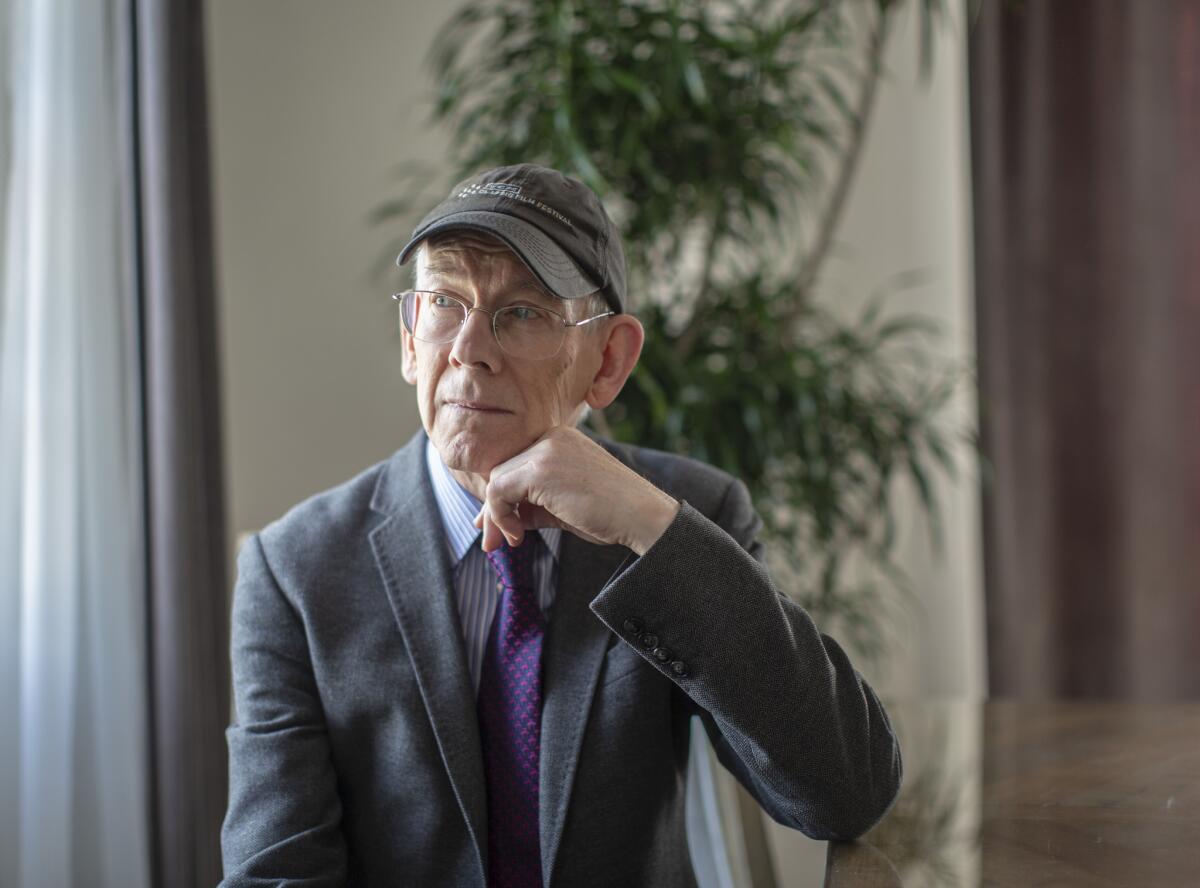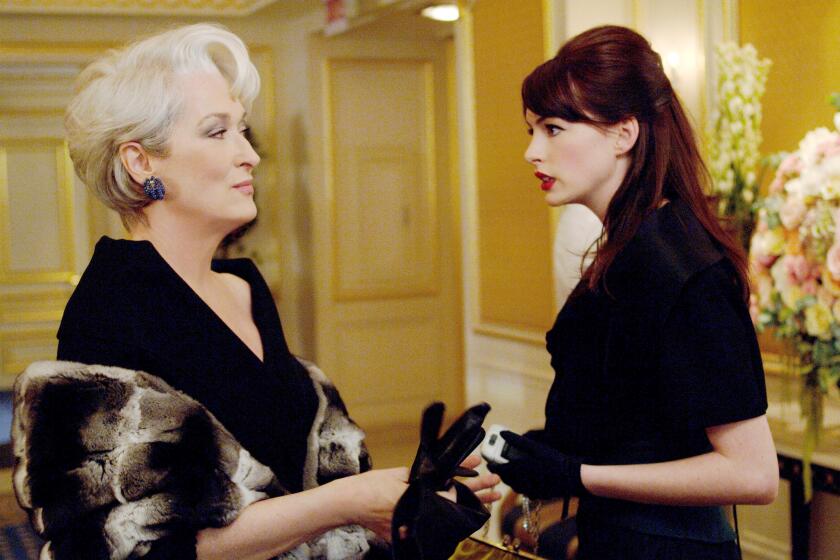Classic Hollywood: For generations, Kevin Brownlow has been the voice for silent films

- Share via
Kevin Brownlow has been the voice for silent films and their preservation and restoration for six decades. In fact, the 80-year-old British filmmaker, historian and author earned an honorary Oscar for his work in 2010.
Brownlow, who began collecting silent films at age 11, has written acclaimed film books including “The Parade’s Gone By” (1968); “Hollywood: The Pioneers” (1979); and “The Search for Charlie Chaplin” (2005). He also directed two feature films with Andrew Mollo, “It Happened Here” (1964) and “Winstanley” (1975).
In 1980, he and David Gill produced and directed the landmark 13-part TV series “Hollywood.” Other documentaries from the pair include “The Unknown Chaplin” (1983) and “Harold Lloyd: The Third Genius” (1990). His most recent documentaries include “Garbo” (2005).
Among the countless silent movies he’s restored are Abel Gance’s 1927 epic “Napoleon,” the 1925 “Ben-Hur: A Tale of the Christ” and 1927’s “Sunrise: A Song of Two Humans.”
The sweet, “Mr. Chips”-esque Brownlow was in Los Angeles earlier this month for the TCM Classic Film Festival to receive the second annual Robert Osborne Award for his work preserving and restoring films. TCM screened “It Happened Here” and his restoration of the 1928 Greta Garbo-John Gilbert romance “A Woman of Affairs,” complete with Carl Davis conducting a full orchestra in his original score for the silent classic.
Before the festival, Brownlow sat down to talk about his lifelong love affair with silent films at — appropriately enough — the Gable & Lombard suite at the Hollywood Roosevelt.
Q: What are your feelings about digital restoration versus photochemical restoration?
A: I was bitterly opposed to it until I did the digital work on “Napoleon” and it looked absolutely terrific. One forgets how many times people have come up to me to say that film has changed my life.
Q: Almost three-quarters of all silent films are considered lost. But I imagine you have a list of films you’d love to find and restore.
A: Well, I can give you 17 pages closely typed, but one that stands out is called “Hollywood.” Made in 1923 with a new un-tried girl in the lead with a wonderful name of Hope Drown. And it had everybody in Hollywood in it.
Q: Carl Davis composes the wonderful scores for your silent film restorations. But I can’t tell you how many times I’ve heard inappropriate scores that ruin silent movies.
A: I think the modern enemy of silent films is music from modern composers who have no sympathy for the film at all. I saw “The Four Horseman of the Apocalypse” in Paris with a band they’d picked up off the street, and it was just unbearable.
Q: Is it harder to get younger people interested in silent movies today?
A: Because the National Film Theatre [in London] has cut back on silent films, it’s fallen to an organization at the Cinema Museum, which, oddly enough, was the workhouse where the Chaplin family was incarcerated every so often. And the young people who come to that are extremely enthusiastic.
When sound came in, there was a danger that people would watch a few sound films and want to go back to silent. So producers took very, very primitive [silent] pictures, ran them too fast with honky-tonk music. As a result, that generation, the World War II generation., absolutely hated silent films. What is so fascinating is that there isn’t that prejudice against them anymore. In my youth people would say, “Oh, stay away from silent pictures; they’re so badly made, the photography is terrible, and the acting is ridiculous.”
Q: I read that your boarding school was so awful that one way to keep students from running away was to show silent films.
A:This place was like Colditz. I’m not exaggerating when I tell you the boys escaped; they had to be rounded up by tradesmen’s vans going all over the countryside. The only decent thing the headmaster did was to show us films every third Sunday in the winter in the cold chapel.
I think what attracted me first was the fact that you could put a cinema, which I thought had to be a gigantic bunker in the high street, in your own home, and that transformed things for me. I begged my parents to give me a projector, and indeed they did, that same Christmas. But because they misunderstood, they gave me a still projector. But then next Christmas, I got a hand-crank projector and two films.
It wasn’t enough, of course. I wanted some more, and I went out into the streets of London. I tracked down a photographic shop off Baker Street with a little pile of these films, which were in metal cases. I took them home, and I didn’t know what on earth they were. The first one I ran was missing a main title. I put it on, and my mother said, “That’s Douglas Fairbanks,” her favorite actor. Even I’d heard of that name, and I remember rushing off to the library to look up and see if I could find more information on it.
Anyway, I thought what would happen was I would pull out a book from the library, it would fall open at a picture of my film, and that’s exactly what happened. I went to the library and this one book, “History of the Film,” fell open at a picture and gave its proper title, “American Aristocracy.”
I just had discovered the British Film Institute, found the full cast of this film. The villain was [played by] Albert Parker, so I rang him up and said, “Does the name Douglas Fairbanks mean anything?” And he said, “Doug? Jesus Christ, I directed him.” So, I said, “Oh, what did you direct?” He said, “The Black Pirate.”
Q: Oh, my God.
A: My words exactly. I told him about this little film and he said, “Bring it over.” And he was so entranced to see himself in 1916, so he and he wife organized an evening for his clients because he was an agent. So we got Trevor Howard, Clive Brook, Hardy Kruger. Parker was very friendly and warm. We had dinner after dinner after dinner. It became a thing of silent films at Al Parker’s, and visiting American filmmakers would be invited. It was fantastic. Then he’d ring me up and say, “Kevin, King Vidor is at the Hyde Park Hotel. Tell him I sent you.”
Q: So that’s how you began interviewing all of those legends of the silent screen.
A: I took a huge tape recorder the size of that chair to the Hyde Park Hotel, and King Vidor described the making of “The Big Parade.” I will never forget what he said about his directing style: “I didn’t actually say very much, but I felt it and I’ve realized that they were doing what I thought. Osmosis, you know. And I’d think something, and John Gilbert would react a few moments later.”
Q: I’m jealous that you were friends with Harold Lloyd and visited him at his famous mansion, Greenacres.
A: Harold opened the doors of Greenacres and said, “Only 42 rooms, but it’s home!”
More to Read
Only good movies
Get the Indie Focus newsletter, Mark Olsen's weekly guide to the world of cinema.
You may occasionally receive promotional content from the Los Angeles Times.











